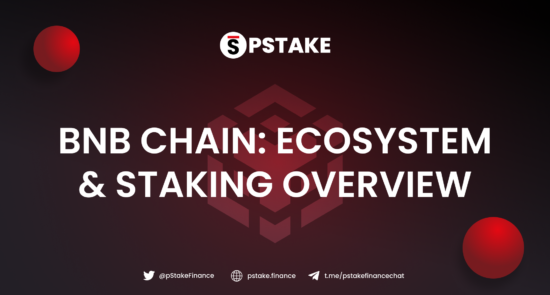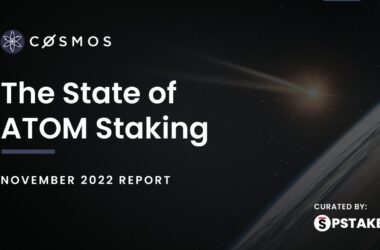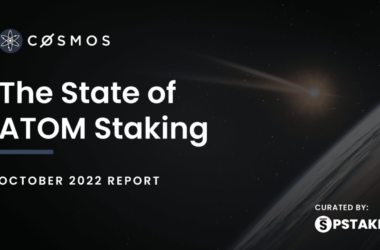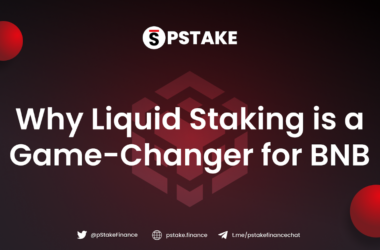As blockchain adoption has continued to soar, so has the demand for highly efficient and scalable solutions. Innovation is accelerating and the industry is becoming increasingly competitive as users flock to find networks that best cater to their UX needs.
Binance, the world’s largest cryptocurrency exchange and an industry leader, took a massive leap forward with the development of its BNB Chain – an efficient, scalable blockchain network and ecosystem that’s made waves in the crypto space.
Today, it stands as one of the most prominent and utilized blockchains in the industry, offering a seamless user experience along with advanced features and technology optimized for retail users and developers alike.
To better understand the BNB Chain and its strong rise to prominence, we’re providing an in-depth review of the BNB Chain network, key statistics, BNB token utility and staking, as well as currently available stake pools.
Additionally, we’ve created a visual overview of BNB Chain’s ecosystem so you can see it a glance:
What is BNB Chain?
BNB Chain was created in February 2022 as a combination and rebrand of BNB Beacon Chain (formerly known as Binance Chain) and BNB Smart Chain (BSC), formerly known as Binance Smart Chain.
Its development marks the next leap forward for Binance, keeping the interconnectivity of the two aforementioned chains intact through relayers while optimizing their interoperability. Furthermore, it aims to deploy the necessary infrastructure to elicit mass adoption and create a more vibrant ecosystem for Web3 applications to scale and flourish, particularly those residing in the DeFi, NFT, and GameFi areas.
Core Components
BNB Beacon Chain
BNB Beacon Chain allows for the exchange and trading of digital assets on the platform (i.e. the Binance DEX, development of dApps, and BNB Chain governance via staking and voting). It’s fueled by a powerful matching engine deployed on distributed consensus attempting to replicate the under 1-second trading efficiency of CEXs (centralized exchanges).
The chain also allows users to:
- Store, send, receive, and trade digital assets
- Mint or burn, freeze or unfreeze, and lock or unlock their tokens on the exchange
- Issue new digital assets and propose listings for trading pairs
For more information on BNB Beacon Chain, please refer to this document.
BNB Smart Chain (BSC)
BSC is a self-sovereign blockchain designed to bring programmability and interoperability to BNB Beacon Chain. It’s EVM (Ethereum Virtual Machine) compatible, allowing Ethereum-based applications to run on its network.
Moreover, it has the ability to enable smart contracts, contains consensus layers, and allows for connections to other chains – efficiently and securely – through cross-chain transfers. In terms of on-chain governance, it utilizes a PoSA (Proof of Staked Authority) consensus mechanism, which will be explained later.
To learn more about BSC, please refer here.
BNB Sidechain & ZkRollup
Two additional key components are the BNB Sidechain, which comes with pre-built PoS solutions to deploy customized blockchains and dApps with BSC architecture, and BNB ZkRollup, which is a solution that will help scale BSC in terms of transaction speeds and overall efficiency (coming soon).
More information on both solutions can be found here.
Features & Ecosystem
BNB Chain was built to be scalable, decentralized, open-source, multi-chain, and permissionless, providing developers with the tools they need to deploy innovative smart contracts and dApps while enabling fast, efficient, and low-cost transactions in DeFi.
Moreover, the chain is known for its clean and powerful user interface, allowing for a seamless experience when facilitating transactions and interacting with dApps.
Its rich ecosystem is currently made up of 1,400+ projects and 244,000+ active users at the time of writing – and the list keeps on growing. Some of the most well-known projects built on the BNB Chain include PancakeSwap, Wombat Exchange, Alpaca Finance, Venus Protocol, and Tranchess.
Token Standards
The Binance ecosystem leverages two token-type standards: BEP-2 and BEP-20.
BEP-2 tokens are issued and utilized on the BNB Beacon Chain for transactions taking place on the platform’s CEX (centralized exchange) platform and DEX (decentralized exchange). It’s important to note that these assets are not usable elsewhere – only on the main platform.
On the other hand, BEP-20 tokens are designed specifically for the BNB Chain and are compatible with all BEP-2 and ERC-20 tokens. Therefore, these assets are able to connect with other blockchains via bridges and are usable throughout the entire decentralized ecosystem outside of the main trading platform.
Key Network Features & Statistics
BNB Chain is a growing and thriving ecosystem amongst its competitors, with 7.52+ million active addresses over the last 30 days and 3.7+ million in daily transactions at the time of writing.
Below is a list of current key statistics surrounding the chain’s ecosystem:
- Market Cap: $36.6+ billion
- TVL: $5.9+ billion
- Active Users: 244K+
- Daily Trading Volume: $1+ billion
- # Unique Wallet Addresses: 174,681,475
Currently, BNB Chain stands as the most active smart contract blockchain when it comes to the number of executed transactions. As of today, the chain processes 3.7+ million daily transactions as opposed to Ethereum’s 1.1+ million, signifying over a 2.8x difference. This can be highly attributed to not only substantially lower gas fees, hovering around $0.19 per transaction, but also its rapid speeds and scalability.
In addition, the number of onboarded users on the chain is soaring, with a 109%+ increase in unique wallet addresses over the last year alone (surpassing 174 million as noted above).
$BNB Token
$BNB (Build and Build), formerly known as Binance Coin, is the native token powering the BNB Chain ecosystem. It serves a variety of important purposes to help drive and sustain the overall network in a decentralized manner.
Here is a list of the token’s core use cases and features:
- Payment mechanism i.e. gas for transactions on the network and paying for goods/services
- Requirement for participation in decentralized, on-chain governance where holders can influence the chain’s future direction through voting on proposals
- Acts as a staking mechanism where users can secure the chain and earn rewards
- Provides access to token sales (IDOs, ICOs) on the Binance Launchpad
When it comes to Binance’s token standards, users can leverage their $BNB only for transaction fees (as a BEP-2 token standard) on the platform’s CEX and DEX. If $BNB is used as a BEP-20 token (outside of the main platform’s bounds) it can be utilized across the entire Binance ecosystem of dApps.
$BNB Staking Functionality
Staking $BNB is a fundamental activity that helps provide security and robustness to the chain’s underlying infrastructure. At the time of writing, the chain’s total staking market cap exceeds $4.1 billion.
Validators & Mechanism
There are currently a total of 43 validators, the top 21 of which are able to support and validate the network in return for rewards. BSC has plans to onboard an additional 20 inactive validators (called “Candidates”) into the set as backups. Additionally, there are over 18.5 million bonded $BNB tokens on the chain, equaling a staking ratio of ~11% relative to the circulating supply of ~163 million tokens.
As previously mentioned, BSC uses a PoSA consensus mechanism, a hybrid of DPoS (Delegated Proof of Stake) and PoA (Proof of Authority) that allows for very short block times and lower costs.
Nodes need to stake a user’s $BNB in order to become validators, which are selected every 24 hours – validators can also self-delegate $BNB to themselves and receive delegations from other holders.
To ensure the networks remain compatible, BSC’s staking logic is implemented on BNB Beacon Chain – this means that its token bond and delegation actions and record keeping actually happen on BNB Beacon Chain.
Rewards
Validator updates and reward distributions occur daily – block rewards are collected on BSC and distributed to active validators and delegators across both networks.
The $BNB token is not inflationary, therefore there are no mining rewards factored into the tokenomics – gas fees serve as the primary reward for network validators. Validators also have the ability to determine the reward amount to distribute to delegators staking $BNB to them.
At the time of writing, $BNB validators are currently providing staking rewards of up to 6.53% APR as an incentive to participate in staking and support network consensus.
Slashing
Slashing is an essential part of the governance process to ensure validators are penalized for malicious behaviors, such as double signing or being offline/unavailable for long durations. In the event that this occurs to a validator, their self-staked $BNB is slashed (their loss isn’t shared by their delegators) and they’re indicated as being “in jail.”
A 7-day unbonding period has been instated for validators and delegators to ensure tokens are bonded when bad behaviour is detected.
Conclusion
Given BNB Chain’s vast and ripe ecosystem, including its robust architecture and mechanics, the network makes for the ideal environment for both users and developers to capitalize on what it has to offer.
We hope this overview helped provide a more comprehensive understanding of the ins and outs of BNB Chain. With Binance continuing to build and innovate on BNB Chain, more exciting developments and features are surely on the way.
About pSTAKE
pSTAKE is a liquid staking protocol that unlocks liquidity for your staked assets. With pSTAKE, you can securely stake your Proof-of-Stake (PoS) assets, participate in protocol improvements and security to earn staking rewards, and receive staked underlying representative tokens (stkASSETs) which can be used to explore additional yield opportunities across DeFi.
At present, pSTAKE supports Binance Chain (BNB), Cosmos (ATOM), Persistence (XPRT), and Ethereum (ETH) networks’ native tokens, with a view to support more chains and assets in the future (SOL, and AVAX).
Developed by Persistence
Persistence is a Tendermint-based, specialised Layer-1 network powering an ecosystem of DeFi applications focused on unlocking the liquidity of staked assets.
Persistence facilitates the issuance and deployment of liquid-staked stkASSETs, allowing users to earn staking rewards while participating in DeFi primitives, such as lending/borrowing and liquidity provisioning on DEXs.
Persistence aims to offer a seamless staking and DeFi experience for PoS (Proof-of-Stake) users and enable developers to build innovative applications around stkASSETs.
Join Our Movement
Twitter | LinkedIn | Telegram | YouTube | Reddit | [email protected]










